
Upon entering the galleries of El Museo del Barrio’s current show, Luis Camnitzer, visitors come face to face with the following lines, handwritten on the wall in loose script:
If I draw a dot on one sheet of paper
I am a doodler.
If a draw a dot on one hundred sheets of paper
I am a philosopher.
If a draw a dot on one thousand sheets of paper
I am a mystic.
If I draw a dot on ten thousand sheets of paper
I am a modern conceptual artist and may become
rich and famous.
Social values are a matter of accumulation.
Part statement and part poetry, these words provide an apt introduction to both the artist and exhibition on view. Witty, wry, and with a hint of self-deprecation (Camnitzer IS a modern conceptual artist, after all), the piece introduces the viewer to the type of insightful reflection that is characteristic of the artist, whose work often confronts issues related to politics, the art world, and society at large, through oblique, yet cutting critique. Further, written in pencil and only faintly hovering against the gallery’s white wall, the work requires close inspection, thus presaging the type of intimate looking (and thinking) required of visitors throughout the show.
On view at El Museo through May 29th, Luis Camnitzer highlights works in diverse media – photography, printmaking, installation – executed during the past five decades of the German-born, Uruguayan artist’s career. A travelling exhibition curated by Hans-Michael Herzog and Katrin Steffen, the show was organized and first shown at the Zürich-based private collection, Daros Latinamerica, which boasts the largest institutional collection of Camnitzer’s oeuvre. Yet, although conceived abroad, the exhibition’s appearance at El Museo is fitting for a number of reasons. First, as a significant, yet conventionally ignored Conceptual artist, Camnitzer is a more than appropriate subject for the institution’s FOCOS series, which is dedicated to showcasing mature, yet under-recognized artists. Second, Camnitzer’s ties to El Museo date back many years: in 1994, the artist co-curated The Latino Papers: Posters, Prints and Works on Paper from El Museo el Barrio’s Permanent Collection; in 1995, he received a solo exhibition at El Museo entitled AMANAPLANACANALPANAMA; and works by the artist are in the museum’s permanent collection and have been featured in various group exhibitions. Perhaps most appropriate for the venue, however, is Camnitzer’s long-standing presence in the New York City art scene. After growing up in Uruguay (where his family moved in 1939 to escape Nazi persecution), Camnitzer emigrated to New York in the mid-1960s. Since then, the artist has participated in a number of important artistic developments, including the founding of the New York Graphic Workshop (1964-1970).

Established with Jose Guillermo Castillo and Liliana Porter, the New York Graphic Workshop employed printmaking processes to create works of Conceptual art. Included in the show at El Museo are a number of pieces from this early period, which serve to demonstrate both the technical innovations and intellectual ideas that members of the workshop pursued. For example, evidence of the variety of objects/materials subjected to the workshop’s printing skills is provided in Camnitzer’s 1967 piece, Fragment of a Cloud. Composed of thinly stretched cotton wool, upon which the work’s title is printed, Fragment of a Cloud illustrates the artist’s mastery of his medium, causing viewers to wonder how the delicate white gauze/cloud was ever able to support such heavy, bold stenciling. The semiological implications involved in the labeling of cotton as cloud are similarly addressed in other works to varying degrees of complexity and nuance, ranging from Camnitzer’s Horizon (1968) to his famous This is a Mirror You are a Written Sentence (1966-73). With works executed in both Spanish and English, Camnitzer’s explorations into the meaning of language certainly resonate with his transnational and multilingual personal history. However, rather than circumscribing Camnitzer to a particular “Latin American” perspective, such pieces place Camnitzer in clear conversation with his more broadly recognized peers, like Lawrence Weiner.

Beyond Camnitzer’s obvious engagement with and vital participation in his own contemporary period, art historical references abound throughout his oeuvre. In her introduction to the show, Deborah Cullen, El Museo’s Director of Curatorial Programs, deems Camnitzer “an artist’s artist,” thoroughly and intellectually engaged with his profession. Indeed, in addition to working as a professional artist, Camnitzer is a critic, teacher, scholar, and the author of such books as New Art of Cuba (1994, 2003) and Conceptualism in Latin American Art: Didactics of Liberation (2007). At the El Museo show, this art historical background is present in such satirical works as his riff on L.H.O.O.Q. in Homage to Duchamp (1980). In another piece, Camnitzer takes a page from Rauschenberg in his Pencil drawing done after L. Cranach’s ‘Pythagoras as Discoverer of the Musical Intervals’ and Erased from the Paper (1974), presented as a vial of graphite shavings encased in a wood frame. A work in a similar vein is the 1975 Etching by Picasso, ‘Model and Surrealist Sculpture’ Vollard Series #74, 1933, converted into one single line, one thread, one spiral, in its precise length [813cm]. However, at the heart of these fun/funny pieces are serious artistic statements – after all, what does it mean for a Latin American printmaker to undo a work from the Spanish master’s well-known print series?

Such investigations into the history of artistic production and his own position within it are taken up by Camnitzer in a number of pieces that consider the value of the artist’s touch. A concentration of these works is displayed in the exhibition’s first room, in which the artist’s signature takes center stage. Representing a tangible point of contact between creator and creation, the artist’s signature is traditionally understood as a mark that not only lays claim to artistic conception, but also endows a work with the artist’s aura. Parodying such ideas, Camnitzer makes his signature the very core of his pieces: he copies it and addresses issues of originality and reproduction [Copia (1972)]; he enlarges it to sell the size [Fragmentos de firma para vender por centímetro (Fragments of a Signature to Be Sold by Centimeters), 1972]; he even laser-cuts it into a loaf of bread intended to be sold by the slice, thus realizing the connection between the artist’s signature and dough ($) [Firma para vender por tajadas al peso [Signature to Be Sold by the Slice and by Weight], 1971-1973]. Such impish, tongue-in-cheek gestures inevitably recall other art world pranksters like Piero Manzoni and Yves Klein. However, set against the backdrop of Minimal and Conceptual art, at a time when the likes of Donald Judd and Carl Andre were striving to erase any indications of the artist’s presence in their works, Camnitzer’s pieces take an almost inverse stance in their approach.

Of course, implicit in Camnitzer’s signature works are critiques of the art market and its modes of valuation. These ideas are carried throughout the show in a number of different pieces, but come to an interesting climax in the exhibition’s final gallery with Pintura original mural (1972). There, two rectangles of identical shape and color are painted onto the wall. On one, an e-mail invoice from Alpine Painting and Sandblasting is casually taped. The invoice lists the price of prepping, labor, and materials that went into creating the rectangle and comes to a grand total of $489.94. The costs for creating the rectangle are also enumerated onto the other piece – however, there they are handwritten, accompanied by Camnitzer’s signature, and total $42,950. The reason for this price hike? Additional costs for concept ($20,000), signature (determined by the inch, $40.99), and gallery commission ($21,475) have been factored in, presenting an intriguing distribution that seems to preference the art market over the artist.

In addition to his criticisms about the art world, Camnitzer is perhaps most famous for his politically based works. Indeed, having narrowly escaped the Holocaust and World War II in Germany, and having monitored the repressive dictatorship of 1970s-80s Uruguay from New York, Camnitzer has experienced politics, and particularly political repression, as a powerful force in his life. Camnitzer’s reactions to political events have been made explicit in works such as his 1970 piece, Leftovers, consisting of a wall of cardboard boxes from which blood seems to ooze, and his Uruguayan Torture Series (1983-84), seen at El Museo in 1997 as part of the travelling exhibition, The Disappeared. Such haunting works are absent from the present exhibition, perhaps due to the fact that the pieces on view are all from the Daros Latinamerica collection, leading one to wonder if perhaps the neutral Swiss are not interested in works dealing with political violence. Whatever the case, it must be admitted that politics are not entirely absent from the show, the most striking example being Camnitzer’s 1991 work, El Viaje. Carefully placed behind a stanchion, this piece consists of three knives that project from the wall, blades out and with two shiny Christmas ornaments hanging from each. Phallic symbols, the knife blades are inscribed with the names of Christopher Columbus’s three ships that landed on the virgin, fertile territories of the New World in 1492, forming a potent commentary on Latin American colonialism.


Scattered throughout the galleries dedicated to temporary exhibitions at El Museo, the works in the Luis Camnitzer exhibition are sparsely installed, particularly compared to other recent shows (notably, Nexus New York and Nueva York), in which the galleries seemed to almost explode with both artworks and wall text. Yet, while the plethora of content presented in those shows stood as testament to the richness of their themes, the more controlled display of the current exhibition enhances Camnitzer’s art, allowing for the type of prolonged reflection that his work demands. However, this sense of curatorial restraint is not to say that the installation is boring or tedious – indeed, on the day that I visited, the galleries had a certain vibrant hum to them as groups of visitors walked together and discussed the art. Such active engagement is implied by the very nature of the works, including the piece Selbstbedienung (Self Service) of 1996. Placed near the entrance of the gallery, the Selbstbedienung consists of stacks of paper that are each printed with a slogan. Next to the stacks is an inkpad and rubber stamp bearing Camnitzer’s signature. Viewers are invited to pick a paper and, for the price 25 cents, “certify” it with Camnitzer’s autograph in an exercise that points to so many of the issues brought up throughout the show. Or, perhaps the piece can be understood as simply “a souvenir,” as one of the guards explained to me while I stamped Camnitzer’s name onto a paper reading “Adquisicion es Cultura” (Acquisition is Culture).
Luis Camnitzer is on view through May 29, 2011, at El Museo, 1230 5th Avenue. El Museo will host free artist-led walkthroughs of the exhibition: with Alejandro Cesarco on April 13 and with Judi Werthein on April 27. RSVP required.
Susanna Temkin is a PhD candidate at the Institute of Fine Arts, focusing on twentieth-century Latin American art.

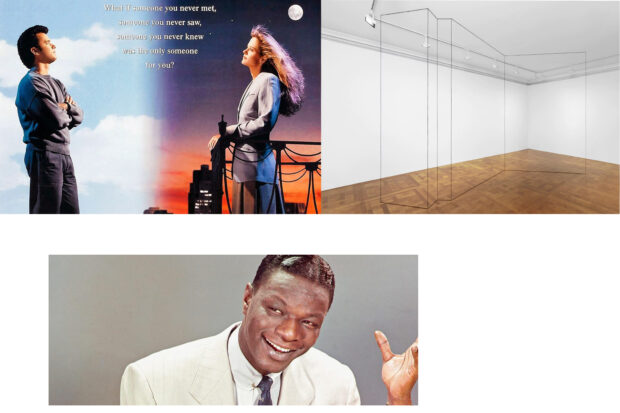
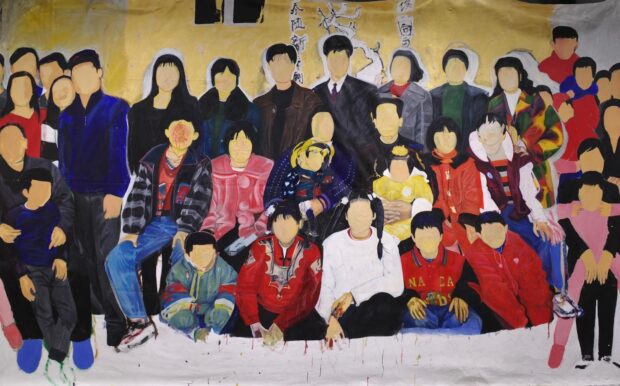
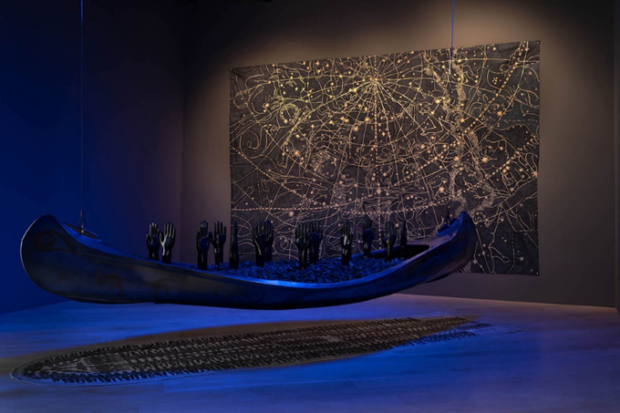
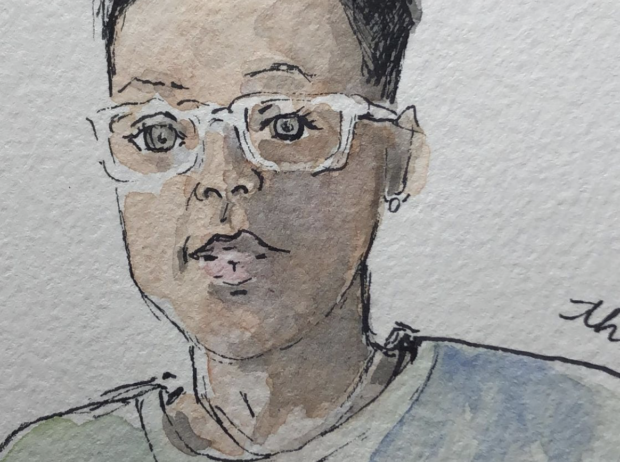
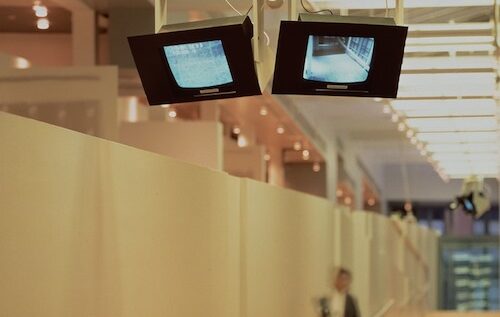
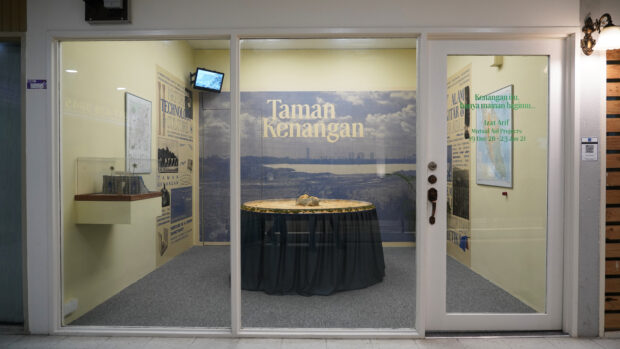



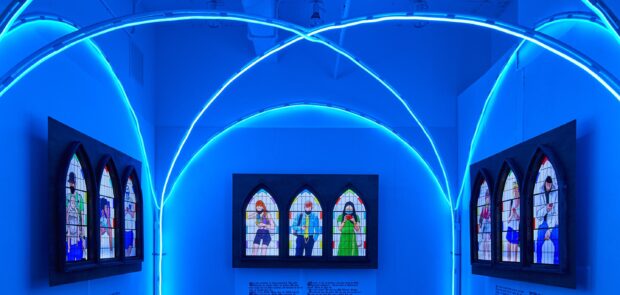

[…] detailed look at Luis’s work click and more pictures from the show have a quick look at on IFA at NYU Share this:ShareFacebookTwitterEmailStumbleUponLike this:LikeBe the first to like this […]
I think that it is also important to mention the relationship that Camnitzer is also making with the Christmas ornaments in El Viaje . The first settlement in the “new world” was called ‘Fuerte de la Navidad’ (The Christmas Fort) and it was built out of the remains of the ship La Santa María.
Interesting article!
Fantástico deslumbrante